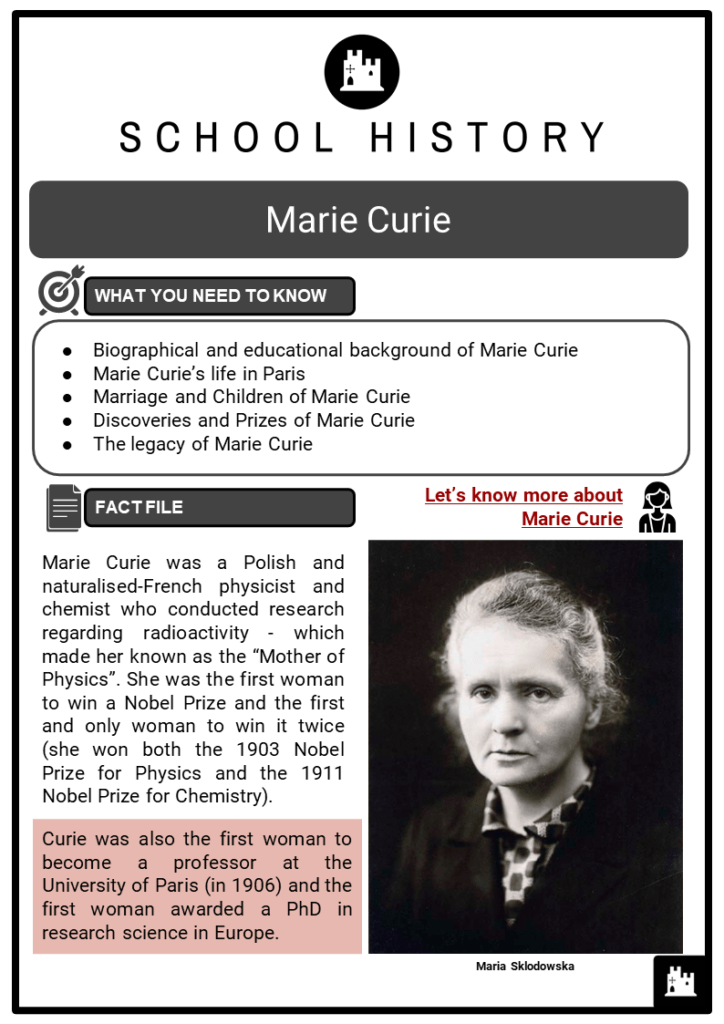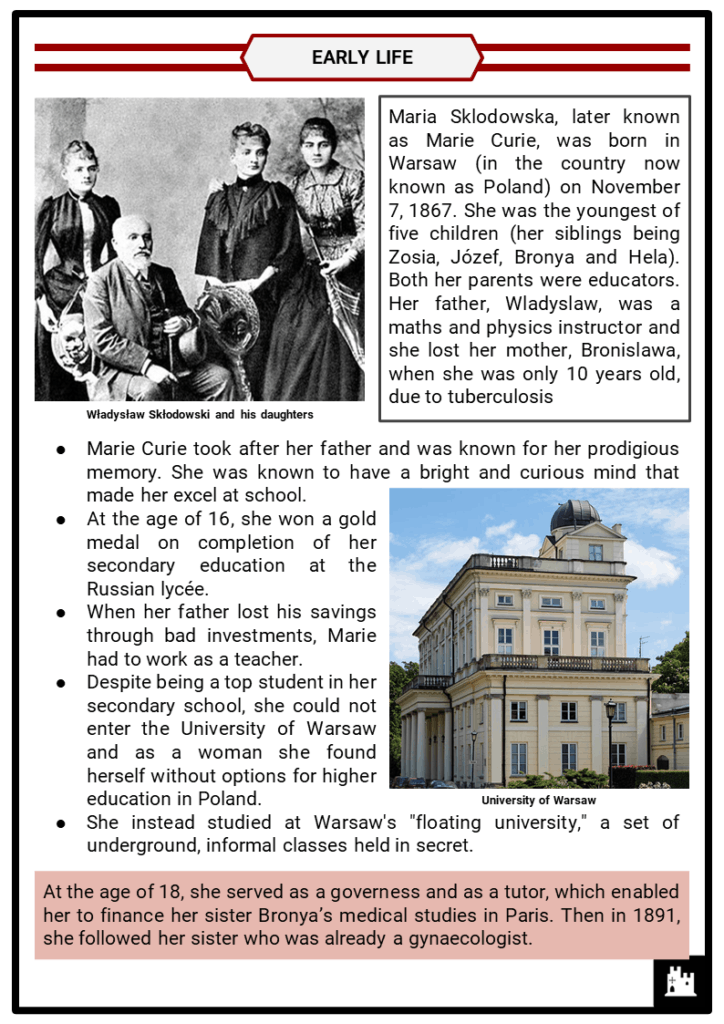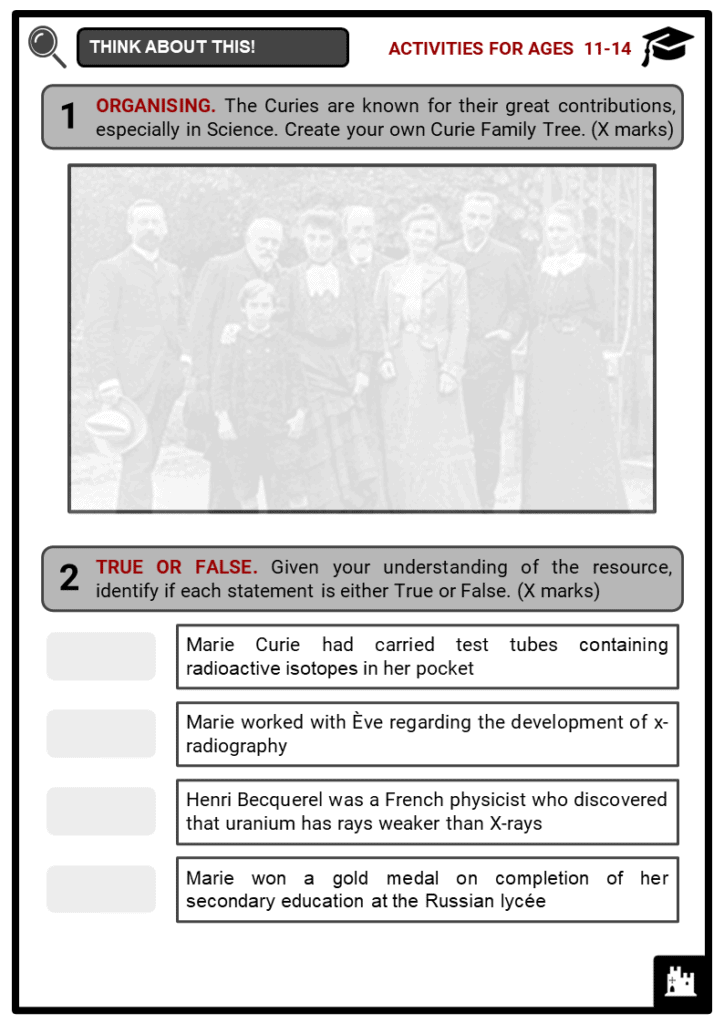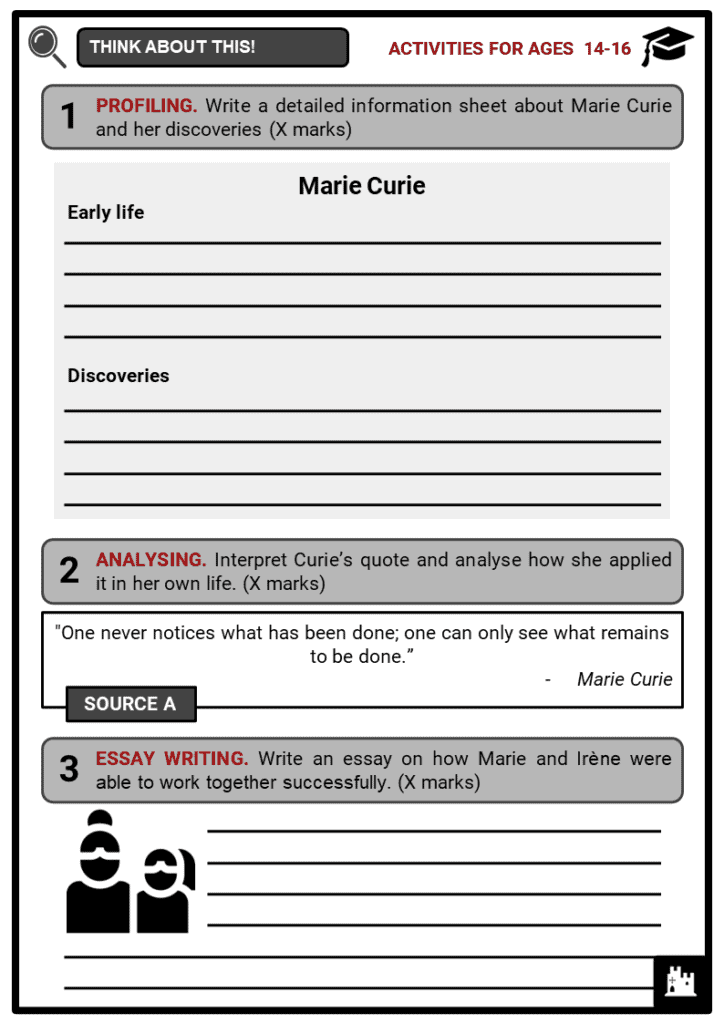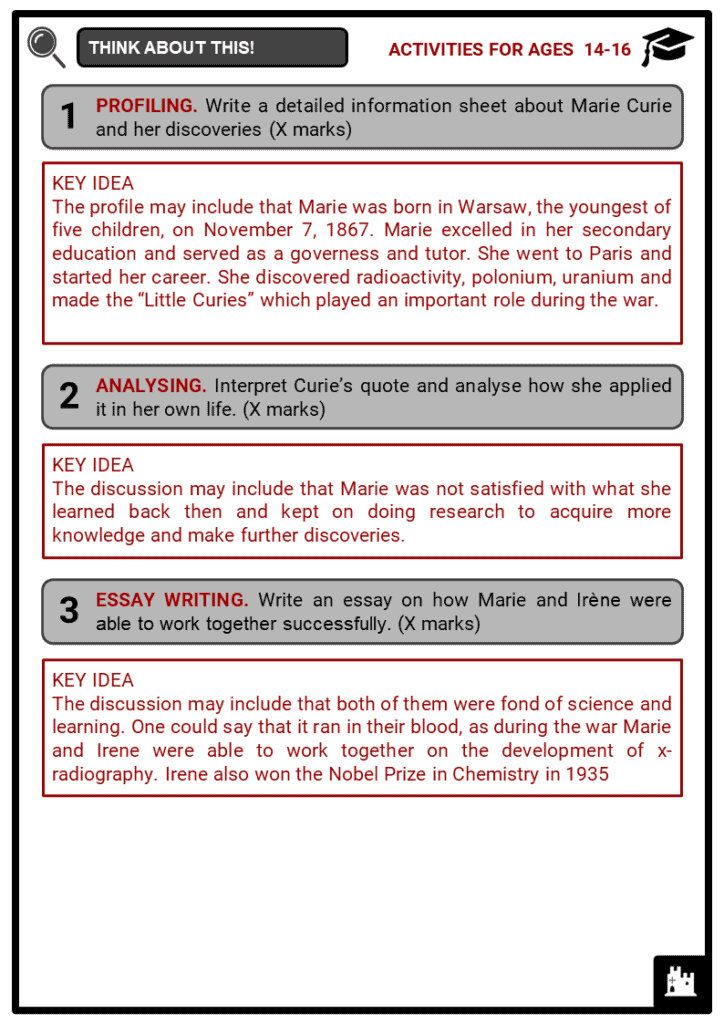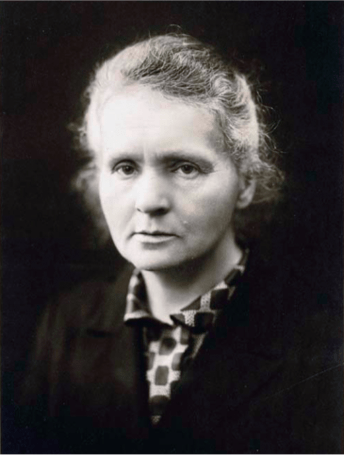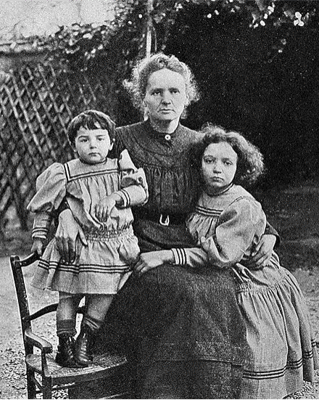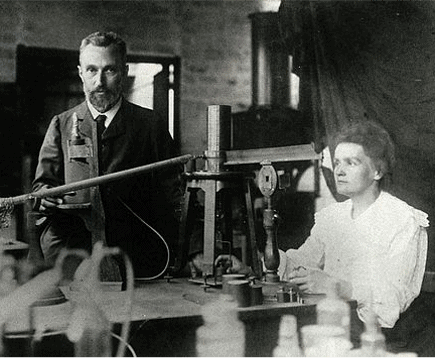Download Marie Curie Worksheets
Do you want to save dozens of hours in time? Get your evenings and weekends back? Be able to teach Marie Curie to your students?
Our worksheet bundle includes a fact file and printable worksheets and student activities. Perfect for both the classroom and homeschooling!
Table of Contents
Add a header to begin generating the table of contents
Summary
- Biographical and educational background of Marie Curie
- Marie Curie’s life in Paris
- Marriage and Children of Marie Curie
- Discoveries and Prizes of Marie Curie
- The legacy of Marie Curie
Key Facts And Information
Let’s know more about Marie Curie
- Marie Curie was a Polish and naturalised-French physicist and chemist who conducted research regarding radioactivity - which made her known as the “Mother of Physics”. She was the first woman to win a Nobel Prize and the first and only woman to win it twice (she won both the 1903 Nobel Prize for Physics and the 1911 Nobel Prize for Chemistry).
- Curie was also the first woman to become a professor at the University of Paris (in 1906) and the first woman awarded a PhD in research science in Europe.
Early Life
- Maria Sklodowska, later known as Marie Curie, was born in Warsaw (in the country now known as Poland) on November 7, 1867. She was the youngest of five children (her siblings being Zosia, Józef, Bronya and Hela). Both her parents were educators. Her father, Wladyslaw, was a maths and physics instructor and she lost her mother, Bronislawa, when she was only 10 years old, due to tuberculosis.
- Marie Curie took after her father and was known for her prodigious memory. She was known to have a bright and curious mind that made her excel at school.
- At the age of 16, she won a gold medal on completion of her secondary education at the Russian lycée.
- When her father lost his savings through bad investments, Marie had to work as a teacher.
- Despite being a top student in her secondary school, she could not enter the University of Warsaw and as a woman she found herself without options for higher education in Poland.
- She instead studied at Warsaw's "floating university," a set of underground, informal classes held in secret.
- At the age of 18, she served as a governess and as a tutor, which enabled her to finance her sister Bronya’s medical studies in Paris. Then in 1891, she followed her sister who was already a gynaecologist.
- She first used the name Marie in Paris where she enrolled at the Sorbonne. Marie was very dedicated to her studies even if it had a personal cost. With only a little money, she survived on tea and buttered bread, and her poor diet sometimes affected her health.
- In 1893, Marie Curie completed her degree in physical sciences, coming first in her class. A year later, she placed second in her degree in mathematical sciences.
Meeting Pierre
- Pierre Curie was introduced to Marie by a colleague in the spring of 1893. Marie needed a laboratory to perform a study on different types of steel and their magnetic properties. Pierre was a French physicist and an instructor at The City of Paris Industrial Physics and Chemistry Higher Educational Institution (ESPCI Paris). Their mutual interest in natural sciences drew them closer. Marie and Pierre became a scientific duo and romance developed between them.
- The pair got married in July 1895 in Sceaux, Paris through civil marriage. In the beginning, the couple worked on separate projects. After Marie discovered radioactivity, Pierre set aside his projects to help Marie in her research.
- Marie suffered a loss in 1906 when Pierre died in Paris after he accidentally stepped in front of a horse-drawn wagon. Despite her tremendous grief, she was able to take over his teaching post at the Sorbonne, becoming the institution’s first female professor.
Children
- The couple had their first child, Irène in 1897. Marie Curie continued to work on her research project then began to work as a physics educator at a girls’ school. They then welcomed their second daughter, Ève, in 1904.
- Irène followed the legacy of her mother, winning the Nobel Prize in Chemistry in 1935. This award was shared with her husband, Frédéric Joliot, for their work regarding the synthesis of new radioactive elements.
- Ève wrote the first of many biographies about her famous mother, Madame Curie, which later was turned into a feature film.
Discoveries
- Henri Becquerel was a French physicist who discovered that uranium has rays weaker than the X-rays found by Wilhelm Conrad. Being fascinated with this discovery, Marie Curie took his work a few steps further.
- Marie conducted her own experiments regarding uranium rays and discovered that no matter the condition or form of the uranium, the rays remained constant.
- She theorised that the rays came from the atomic structure of the element.
- Marie Curie coined the word radioactivity to describe the phenomena.
- Marie and Pierre studied pitchblende, a mineral with much stronger activity than pure uranium. This was due to the presence of small quantities of an unknown substance with very high activity in the ore. In 1898, Marie discovered polonium (named in honour of her native land) and discovered radium a few months later. Pierre devoted himself to the physical study of the new radiations while Marie spent her time working on obtaining pure radium in metallic state.
- Marie Curie then received her doctorate of science in June 1903 and Pierre was awarded the Davy Medal of the Royal Society. The couple also shared the Nobel Prize for Physics, with Becquerel, for the discovery of radioactivity. Marie was awarded the Nobel Prize for Chemistry in 1911 for the isolation of pure radium, a year after she published her Treatise on Radioactivity.
- Curie was also able to join other famous scientists, including Albert Einstein and Max Planck, in attending the first Solvay Congress in Physics, where they discussed their groundbreaking discoveries.
Further Works
- In early 1911, Marie curie was nominated to the French Academy of Science but was denied election by one vote. Emile Hilaire Amagat said of the vote, "Women cannot be part of the Institute of France." Curie refused to resubmit her name for nomination and did not allow the academy to publish any of her works for ten years.
- In the same year, she was appointed as the director of the Marie Curie Laboratory, a part of the Radium Institute of the University in Paris and of the Institute for Radioactivity in Warsaw.
- Marie Curie devoted her time and resources when World War I broke out in 1914. She put her winnings into war bonds and fitted ambulances with portable X-ray machines called “Little Curies”. Marie established 200 permanent x-ray installations in France and Belgium.
- After the war, her daughter Irène helped her at the laboratory, while working on the development of x-radiography.
- In 1918, the Radium Institute began to operate widely and became a universal centre for nuclear physics and chemistry.
- Marie curie received fame and became a member of the Academy of Medicine.
- She devoted herself to research regarding the study of the chemistry of radioactive substances and their medical applications.
- In 1920, the Curie Foundation was established to work on the medical applications of radium.
- She successfully used her fame to further her research. In 1921, she travelled to the United States to accept a gift of a gram of pure radium for research, from the then-president Warren Harding. In 1924, she published a biography of her husband. She then came back to the U.S. in 1929 to raise funds to buy radium and to establish an institute in Warsaw for radium research.
- In 1932, the Radium Institute in Warsaw was inaugurated and her sister, Bronya, became the director. In 1930, Curie was elected to the International Atomic Weights Committee, which she served until her death. In 1931, she was awarded the Cameron Prize for Therapeutics by the University of Edinburgh
Death
- Marie Curie died on July 4, 1934 of aplastic anaemia - which is believed to be caused by her prolonged exposure to radiation. Since the damaging effects of ionising radiation were not known back then, she carried out her research without modern safety measures.
- Curie had carried test tubes containing radioactive isotopes in her pocket, and she stored them in her desk drawer.
- She was also exposed to x-rays during the war, from unshielded machines while serving as a radiologist.
- Marie Curie’s body was exhumed in 1995. The French Office de Protection contre les Rayonnements Ionisants (ORPI) concluded that Curie could not have been exposed to lethal levels of radiation while she was alive. They emphasised that radium only poses a risk if it is ingested, and suggested that she may have caught her illness due to the use of radiography during World War I.
- She was buried at the cemetery in Sceaux, beside her husband Pierre. In 1995, their remains were transferred to the Paris Panthéon and were sealed in a lead lining, in honour of their achievements. Marie Curie was the first woman to be honoured with interment in the Panthéon.
Image sources:
- https://upload.wikimedia.org/wikipedia/commons/7/7e/Marie_Curie_c1920.jpg
- https://upload.wikimedia.org/wikipedia/commons/thumb/c/c7/Eve%2C_Marie%2C_Irene_Curie_1908.jpg/220px-Eve%2C_Marie%2C_Irene_Curie_1908.jpg
- https://upload.wikimedia.org/wikipedia/commons/thumb/6/6c/Pierre_and_Marie_Curie.jpg/440px-Pierre_and_Marie_Curie.jpg

